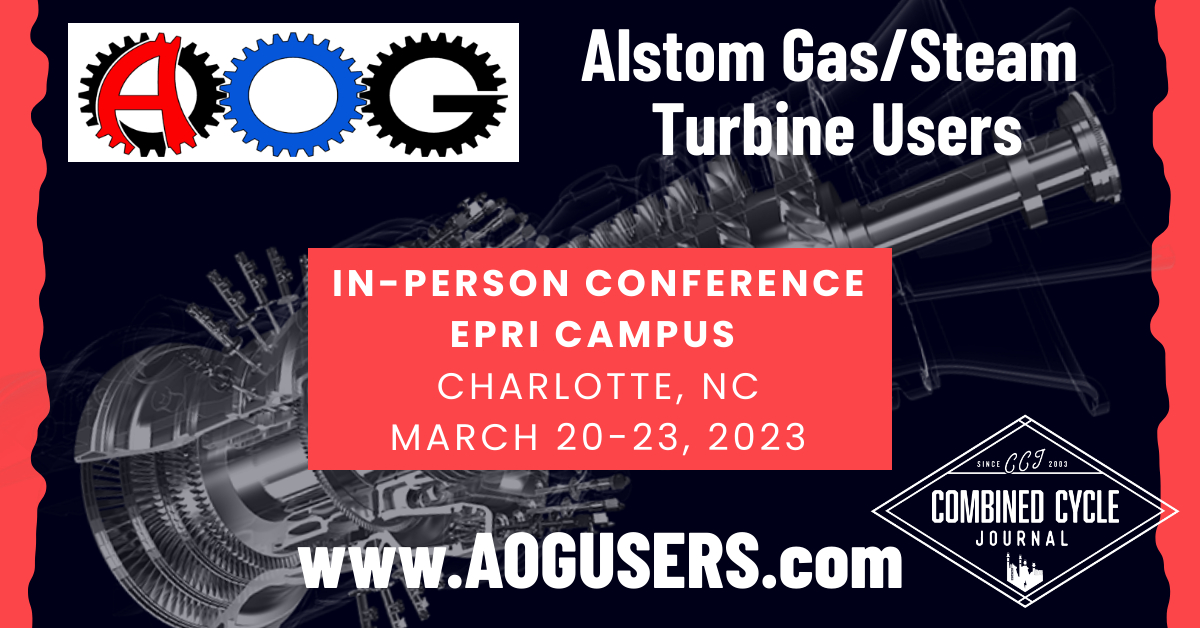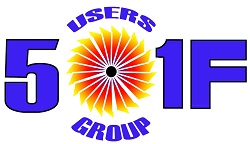
The 501F Users Group is a private community of owners and operators of 501F gas turbine/generators established to discuss the operation, maintenance, inspection, troubleshooting, repair, and optimization of their plants and equipment. Membership in the organization is limited to individuals who are directly involved in the construction or O&M of Siemens Energy, Westinghouse, and Mitsubishi Power 501F, 701F, and SGT6-5000F gas turbines and who are employed by companies with a direct ownership and/or operational interest in those engines.
Annual conferences are developed and moderated by the group’s officers and directors (sidebar). Agenda highlights for the F frame’s portion of the 2023 joint meeting are presented immediately below for Tuesday, Wednesday, and Thursday (half day), February 21-23. Highlights of Monday’s program, for both 501F and 501G users, are in the previous section. CCJ’s printing deadline prevented the sharing of more detail in this special edition for the Reno conference. Updated information is available at the meeting registration desk.
501F Users Group Officers and Board of Directors
President and Chairman of the Board
Ivan Kush, principal CT and controls engineer, Cogentrix Energy Power ManagementVice Chairman
Carey Frost, program manager, Duke EnergySecretary and Board Member
Brian Berkstresser, plant manager, Liberty UtilitiesBoard Members:
Blaine Gartner, principal engineer, Xcel Energy
John Burke, O&M manager, Cottage Grove Power Plant, NAES Corp
Dave Gundry, senior engineer, Xcel Energy
Greg Dolezal, managing director, Klamath Energy LLC (Avangrid Renewables)
Jaime Oliveira, O&M senior manager, Norte Fluminense, EdF
Tuesday, February 21:
First half the morning session encompasses a closed user section and generator roundtable with associated presentations by owner/operators. Siemens Energy’s program follows the refreshments break at 10 a.m. and runs until lunch at noon.
PSM is at the podium for the entire afternoon.
Wednesday, February 22:
Inlet and exhaust and compressor roundtables and their associated user presentations run from the opening bell to the break at 10 a.m. The rotor and hot-gas section roundtables complete the morning program.
Mitsubishi Power is at the podium for the entire afternoon.
Thursday, February 23:
Morning-only program features combustor and auxiliaries roundtables before refreshments and the outage roundtable following. Conference concludes at noon.
Useful Conference Links
- 501F and G users meet together—again (includes Monday highlights)
- 501F Users Group program for 2023
- 501G Users Group program for 2023
- 501F 2022 conference recap: User sessions
- 501F 2022 conference recap: Vendor presentations
- Excerpts from recent 501G plant reports
- Abstracts of recent 501G user presentations
- Remembering Steve Bates

A Covid outbreak a week or so before the 2022 meeting was to start at the Hyatt Regency in New Orleans, February 20, dramatically reduced the number of attendees expected, both user and vendor. Recall that this conference was the group’s return to an in-person program following a virtual meeting in 2021.
Since many owner/operators participating in the 2023 conference were not able to attend last year, the editors have compiled some of that meeting’s technical highlights below to help you “connect the dots” since the 2020 in-person conference.
User presentations
Just shy of a dozen presentations by owner/operators were incorporated into the seven 501F roundtables conducted in 2022: Inlet and exhaust, compressor, rotor, hot-gas section, combustors, auxiliaries, and outage planning and conduct. Summaries follow. Get the details by accessing the PowerPoints on the group’s website at https://forum.501Fusers.org.
Find them in the “2022 Conference Materials” forum post. Only registered users are admitted to this portion of the website.
2021 outage highlights for this unique 2 × 1 combined cycle, described in two presentations, include a steam-turbine major, ST valve inspections, second majors and FD3 upgrades for the gas turbines, and generator inspections on the steamer and one of the gas turbines.
Planning for the outage, the largest in the plant’s history, started in 2019. Given the large amount of work slated for 2021, some was moved forward to 2020 to free up crane time, reduce interferences, and level-out the workload of facility personnel.
History: First unit installed on the greenfield site nearly 30 years ago was a 501D5. A 501FC+ was added two years later. Year 2000 saw installation of a 501FD2 and a steam turbine. Upgrade of the FC+ to FD2 and conversion to the combined cycle followed immediately.
Key topics in the first presentation were implementation of (1) purge credit, to eliminate purging during startup and (2) inlet heating, to improve availability and expand the unit’s operating range. P&IDs are provided for both enhancements. Lessons learned provide valuable guidance.
Note that the current purge procedure uses normal spin-down time at the end of a run to count as the purge credit for the next run. (Consult NFPA 85 for details.) It eliminated the air entrainment into the oil system experienced with the method replaced which was said to have damaged the torque converter wheel. Benefits of purge credit include a 10-min decrease in startup time, longer oil life, reduced stresses on the HRSG, etc.
The second presentation discusses changes to the outage plan made necessary by Covid-19 restrictions, reviews schedule and contractor laydown considerations, and profiles, by way of photos, rotor swaps and upgrades to single-piece exhaust cylinders on both gas turbines.
GT major inspections and exhaust replacements presentation is recommended reading by the editors, who are both familiar with the facility profiled and similar work done at other plants. Original scope of work for this 501FD2-powered 2 × 1 combined cycle, planned as a 30-day effort, was the following:
- Major inspection of one gas turbine with rotor exchange and turbine upgrade, plus exhaust refurbishment. Second GT: upgrade only.
- Steam-turbine medium inspection with bearing and valve replacement.
- Pressure-wave cleaning of both HRSGs, plus floor-liner replacement on one.
- Controls upgrade for the entire plant.
- Generator robotic inspections.
- Rebuilds of one cooling-water pump and one boiler-feed pump.
The work described in greatest detail is that for the exhaust section. Inspections conducted as soon as the units had cooled found that Row 4 tip measurements in one engine were significantly different than those recorded only five months earlier. Plus, two of the unit’s six exhaust struts severed during that time.
For those not familiar with exhaust sections, the presentation provides excellent drawings, complete with detailed callouts, explaining the issues and parts involved. In addition, there are summaries of both fleet and plant experiences involving the exhaust section.
Repair options to correct the major deficiencies identified included weld repair and exhaust cylinder and manifold replacement. A new plan was developed: Extend the outage from 30 to 45 days to conduct majors on both gas turbines and replace the exhaust cylinders and manifolds on both machines.
The presentation concludes with a list of additional findings and corrective actions.
DLN to ULN conversion. Upgrades of SCR systems incorporated in this 2 × 1 combined cycle’s HRSGs were not viewed as adequate to meet new rules governing NOx emissions and expected future limits on ammonia slip. Ultra-low NOx was selected as the preferred solution. It was believed capable of reducing NOx from 25 ppm to 9 to 12 ppm. Pictures describe the work in progress.
Here are the results described by the speaker:
- Plant output decreased by about 5 MW.
- Plant heat rate increased by about 290 Btu/kWh.
- Combustor dynamics were virtually zero.
- Plant is meeting its NOx requirements, but struggling with CO.
- Ammonia consumption has been reduced by about half.
One year of experience with FlameTOP. Presentation discusses recent modifications to one of two gas turbines at this 501FD2-powered 2 × 1 combined cycle that are providing the additional power expected (and sometimes more). Here’s a list of the changes:
- Retrofit of FlameSheet™ combustors to boost engine output and increase efficiency.
- Installation of PSM’s GTOP system, with its hardware upgrades to increase output and extend maintenance intervals.
- Addition of inlet bleed heat to the compressor to increase turndown.
- Installation of AutoTune 3.0/PLP for tighter unit control.
- Retrofit of PSM’s exhaust cylinder and manifold.
- Installation of Arnold insulation for the walls, floor, and ceiling of the exhaust transition duct to reduce performance-robbing heat losses.
FlameTOP7 from PSM is said to increase the simple-cycle output of a standard 501FD2 by 20 MW while reducing heat rate by 3.8%. Unit turndown can extend below 40% of the full-load rating with both FlameSheet and inlet bleed heat installed. NOx emissions are less than 9 ppm across the load range.
After flipping through the slide deck, read “Desert Basin reports experience, success with first 501F FlameTOP7” in CCJ No. 66 (2021) for details.
A second plant also reported a GTOP success, this one involving GTOP6 mods to both engines of the 501FD2-powered 2 × 1 combined cycle—including new combustion hardware, 16th-stage compressor blades, first- and second-stage turbine vanes and blades, and other improvements. The benefits: More than 22 MW of additional combined-cycle capacity and a heat-rate reduction of 80 Btu/kWh.
This presentation is valuable for the balance-of-plant (BOP) assessment described, which was part of the process for evaluating the benefits of upgrading the gas turbines. The report for this effort highlighted safety valves and steam silencers as having insufficient capacity. Plus, the steam turbine’s pressure and temperature limits were identified as a potential limitation, along with both the condensate pumps and the boiler-feed pumps. Changes to safety-valve settings were required, too. Other modifications needed post implementation also are discussed.
Multiple gas-turbine events experienced at a 501F4-powered 3 × 1 combined cycle that occurred during a three-month period are described in this presentation. Here’s a description of the events and what was done to correct them:
- Operators noted that one gas-turbine in the eight-year-old combined cycle experienced a step change in vibration (relative and seismic) and an output loss of about 1 MW. About a week later, personnel reported hearing a fast-rattle/buzz type of noise inside the exhaust end of the machine. It was accompanied by a nominal loss in unit output of about 3 MW. The engine was shut down and inspected. Initial findings: damage to Row 3 and 4 turbine blades, vanes, and ring segments. Repairs were made and the unit returned to service.
- A second gas turbine tripped along with a loud bang and high relative and seismic vibrations. Vibration levels across the unit reached trip levels and were at or above 16 mils. Inspection findings included damage to Row 3 and 4 turbine blades, vanes, and ring segments, plus the rotor, exhaust cylinder, lube-oil piping, and inlet manifold. Repairs were made and the unit returned to service.
- A major inspection was initiated on the combined cycle’s third gas turbine about six weeks after a borescope inspection of Row 3 blades and ring segments did not reveal any significant findings. However, first inspection conducted during the major revealed some distorted Row 3 blade shroud platforms and exhaust-cylinder heat erosion. Unit returned to service after a two-month outage.
Details on how cooling flows and exhaust temperatures were measured at load loads to verify model calculations. Input from Siemens Energy based on RCA results also is summarized.
IGV history/maintenance. The presenter walks you through inlet-guide-vane modifications made over the years to prevent sticking by improving bushing lubrication—the first, for the top half of the bushing, ProdMod 98-1410 in 1998. Westinghouse modified the lower half the following year using the procedure described in ProdMod 99-0240. Siemens Service Bulletin 51004 Rev 2 is recommended reading.
IGV seize-up/icing. The same W501FC+ engine with the sticking problem (summary immediately above) experienced freeze-up when moisture accumulated in some of the IGV bushings (lower half in particular) and the ambient temperature dropped to minus-2F. All blades in Row 1 had ice deposits, those in Row 2 had some ice or frost. Operational information related to mitigation efforts is included in the slide deck.
Problem was resolved by installation of a torpedo heater to defrost ice followed by exercising all the bottom-half IGVs. Borescope inspection revealed no damage. A chart provided by the speaker shows first-stage icing potential at several IGV angles. Attendees were referred to Siemens Energy’s TA 2005-015 Rev 1 to learn more about icing and how to avoid it.
Generator main-lead failure experienced by a South American owner/operator covered problem identification, steps to repair, and lessons learned. Background: Four failures occurred: Broken B phase for the KN steam turbine/generator at this 3 × 1 combined cycle was found in December 2008 and occurred again three months later. Since that time, all main leads have been x-rayed during every turbine outage.
The NDE effort paid off: Phase A in one of the W501FD2 gas turbine/generators was found broken in November 2011 (at more than 900 equivalent starts and 38,000 equivalent baseload hours). T1 failed at the brazed joint below the main lead flange connection to the bushing; x-rays showed cracks in T2, T3, T5, and T6 in locations similar to T1. A second failure occurred in this gas turbine in April 2021 at 1327 ES and 113,453 EBH.
Photos of the first and second GT failures are provided in the presentation together with an overview of repairs, inspections, and tests conducted. Best-effort cleaning also is described.
RCA of a 16-kV flashover. This case history pertains to a unit in reserve shutdown. Incident overview: The GSU and isophase bus (IPB) to the generator circuit breaker (GCB) were energized at 16 kV. A flashover event occurred in the C phase of the breaker on a high-side potential transformer. Inspection revealed water/condensation only in C phase.
Heaters in the IPB were working, but the breaker that feeds heaters inside of the GCB had tripped. Subsequent removal of isophase links at the auxiliary transformer for hi-pot testing revealed water inside of the adapter between the isophase and transformer. Cracks were found in the weld that secures the adapter to the top of the transformer. Photos are provided.
Corrective actions:
- Cleaned and sealed the weld with silicone and spray sealant and began investigating a long-term solution—including possible weld repair.
- Added GCB heater breaker status to plant rounds.
- Planned the addition of humidity sensors and thermometer in the GCB and the transmission of data back to the control system for alarming purposes.
Useful Conference Links
- 501F and G users meet together—again (includes Monday highlights)
- 501F Users Group program for 2023
- 501G Users Group program for 2023
- 501F 2022 conference recap: User sessions
- 501F 2022 conference recap: Vendor presentations
- Excerpts from recent 501G plant reports
- Abstracts of recent 501G user presentations
- Remembering Steve Bates

OEMs for the 501F gas turbine are Siemens Energy, Mitsubishi Power, and GE, with highly capable PSM and Doosan Turbomachinery Services half a step behind—between the manufacturers having their nameplates on the engines and the long list of specialty products/services providers serving this fleet.
Presentations made by Siemens Energy and Mitsubishi Power personnel at the 2022 meeting in New Orleans are not posted to the 501F Users Group website. The former had the podium for only two hours. Its presentations are posted to the OEM’s customer extranet portal at https://cep.siemens-energy.com.
GE did not participate in the meeting.
PSM held the floor for an entire afternoon. The company’s execs and top engineers participated, presenting on recent 501F projects completed and those in the pipeline, 501F FlameTOP (FlameSheet™ and GTOP7), operational flexibility, hydrogen initiatives and roadmap, supply-chain issues and mitigation, 501F repairs (focus on R1 blades and vanes), product-line update (rotors, exhaust, diaphragms), troubleshooting, and service engineering.
While these presentations also are not posted to the 501F website, you can request them from your plant’s PSM representative.
Virtual presentations
The following eight vendor presentations were made during the special 501F virtual Vendorama program conducted at the end of September 2022. Most are updates of what the vendors had to say during the in-person Vendorama program in New Orleans earlier in the year. Access both the slides and recordings of these presos by accessing the 501F Users forum.
PSM, Fuel and operational flexibility: Hydrogen capabilities and the latest on 501F upgrades and developments, highlights some of the 501F fleet activities and R&D projects that PSM will update owner/operators at this meeting.
Environment One Corp, Generator condition monitor for air-cooled machines, discusses the technology’s application and contribution to higher reliability—covering principle of operation, system description, sample applications, and design considerations.
Arnold Group, Advanced single-layer turbine warming system. Detailed system description, operating experience, and value proposition are presented.
Braden Filtration, Air inlet pulse filters: Are you keeping pace with the industry? A thorough assessment of pulse-type filtration systems for maximizing gas-turbine performance. Includes details on fibers, chemical coatings, and membranes.
Catalytic Combustion, Effects of sulfur on CO catalyst when operating at lower temperatures, offers solutions for protecting against catalyst degradation by sulfur contamination.
National Electric Coil, Aeropac I generator challenges, failures, and recovery, provides two case studies with guidance on developing a repair plan and identifying major milestone progressions.
C C Jensen Inc, De-mistifying varnish: Why the CJC VRU varnish removal unit is the safest and most efficient technology. A tutorial that includes varnish characterization, impacts of turbine operation on varnish formation, importance of oil analysis and tests of greatest value, methods of varnish removal, online condition monitoring, etc.
EagleBurgmann Static Sealing Solutions, PulseBreaker™ technology for high-efficiency units and 501F/G maintenance tips. Shares why this new type of gas-turbine exhaust joint is more capable than the company’s traditional quilted design: The latter keeps insulation in place, the former offers better protection for insulation media. Focus is on design details.
In-person presentations
Companies making the following presentations during the February in-person Vendorama program who did not participate in the virtual Vendorama session in September. The slide decks for these presos can be accessed on the 501F website along with the user presentations.
Cutsforth Inc, Case study on electromagnetic interference (EMI) monitoring illustrates the company’s ability to validate an event and prevent a failure. Presentation shows how information from high-speed waveforms, spectrum scans, and data analyses captured from shaft ground monitoring and EMSA were used by SMEs to identify the source of high voltages and arcing and allow repair before the generator experienced significant damage.
EMW filtertechnik, Better filtration pays for itself—Part 2. This is a follow-on to the company’s 2021 presentation, offering a deeper look into the main KPIs of the filter industry and updated results from several gas-turbine projects.
APG-Allied Power Group, 501FD2/3 Row 3 turbine-blade repair and life extension, is vintage Aaron Frost, an industry leader in the subject matter presented. Reviews historical R3 blade designs, inspections, findings during those inspections, characterizations of defects and where they are located and materials affected, and much more. Presentation is particularly valuable for its level of detail and photography. You can go through the slides multiple times and still find things of importance you weren’t aware of.
Doosan Turbomachinery Services Inc, 501F Row 1 blades: Operational and historical repair experience. Focuses on the many design differences among Row 1 blades made over the last 25 years with emphasis on OEMs, materials, and coatings. Advantages and disadvantages from a repair-management point of view are provided, in addition to standard repair recommendations and other considerations for maximum lifecycle management.
B K Vibro America, A method for calculating complex asymmetric distributed weight splits. If a turbine rotor has a significant number of existing balance weights where an additional balance weight is needed, a complex asymmetric weight distribution can be used instead to help minimize the total number and mass of weights needed versus a single simple weight split.
Environex Inc, Is your SCR/CO system ready for turndown?—Part 2 is a follow-on to the company’s presentation in February 2020. Back then the focus was how higher NO2/NOx ratios in exhaust gas were increasing SCR system performance requirements. However, recent field data show another phenomenon is causing even higher NO2/NOx at the SCR catalyst inlet: Lower VOC emissions requirements. Goal of the preso is to help operations personnel better understand what to look out for when specifying SCR and CO catalysts.
Frenzelit Inc’s Expansion joint upgrades for legacy 501FD and 5000F units brings you up to date on product improvements to eliminate the root cause of cracking and premature expansion-joint failures.
HRST Inc’s Considerations for fast ramping and peak capacity walks you through these topics: optimal startup procedures, gas-turbine purge time calculation, purge credit feasibility, steam-turbine considerations, HP-drum ramp rate, tube metal temperature, and nameplate capacity. Goals include helping users (1) avoid startup damage from water pooling in the reheater and superheater when offline and (2) mitigate pressure-part stress from rapid temperature changes.
JASC’s Zero-emissions equipment provides operational readiness for liquid-fuel operation and allows the testing of the liquid-fuel system without burning oil in the turbine. Company’s technology enables fuel-transfer rates approaching 100% and fuel-system flow-control functionality which only requires service at intervals of four to five years.
Moog Industrial, Improvements and upgrades to fuel-gas control-valve assemblies. Describes Moog W501F/G actuator/gas-control-valve lineage and model variations, and control system trends and their impacts on fuel control valves. Plus, benefits and advantages of the company’s new chrome coating process for cylinder bores, and its explosion-proof-rated solenoid-activated dump valve.
Nord-Lock Group, The four-way-joint leak solution described is said to be a robust fix which incorporates hydraulic and mechanical tensioning techniques, and internal seal with adjustable retainers, and improved bolt-hole and flange sealing system. Result: Zero leaks.
Sensatek Propulsion Technology Inc’s Turbotrack™ monitors the actual condition of rotating parts. The company’s on-blade temperature/strain sensor system can be deployed without continuously dismantling the engine, rapidly accelerating testing while reducing costs.
Shell Oil Products, Healthy machines through real-time lubricant condition monitoring. Describes the company’s program for monitoring oil and equipment condition 24/7 to give advance notice of impending mechanical failures while providing continuous remote data-gathering.
Sulzer Turbo Services Houston Inc, Maintaining 501F rotors, shares company’s robust, repeatable repairs and solutions to the following issues, among others: broken alignment fits of forward stub shaft, compressor through-bolt failures, fretted air baffles, and significantly worn disc seal arms. Plus, how Sulzer conducts shop rotor inspections, evaluates findings, and plans steps forward.
SVI Industrial, Repair procedures: The good, the bad, and the ugly, shows through a series of photos how to evaluate HRSG weld repairs. Topics include how to find the leak, Code repair concerns, identifying repair methods, raising/lowering panels for tube repair, plugging tubes, jacking panels, Code requirements for stress relief, key Alloy 91 weld features, post-weld heat treatment, welding method 6, and supplement 8.
Voith Turbo, Collaboration in the “new normal,” discusses the following: improving starting-system availability and reliability, maintenance updates for legacy units, system safety developments, and other topics as well.
Useful Conference Links
- 501F and G users meet together—again (includes Monday highlights)
- 501F Users Group program for 2023
- 501G Users Group program for 2023
- 501F 2022 conference recap: User sessions
- 501F 2022 conference recap: Vendor presentations
- Excerpts from recent 501G plant reports
- Abstracts of recent 501G user presentations
- Remembering Steve Bates
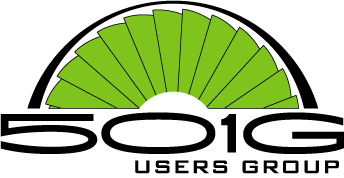
The 501G Users Group is a small organization of well-connected engineers and technicians who have “grown up” together—so to speak—and very familiar with their colleagues’ plants and equipment. The first Siemens/Westinghouse 501G, installed by Lakeland Electric, began commissioning operations in April 1999, but COD wasn’t until March 2001—only one month before the second machine began commercial operation at Millennium.
Steering committee
Chair (acting): Mark Winne, plant manager, Millennium Power Partners
Scott Wiley, outage manager, Vistra Corp
Guy Taylor, plant engineer, Lakeland Electric
John Wolff, technical support/compliance manager, Ironwood, LS Power
Fleet size is small by industry standards—24 engines at 13 sites in the US and one in Mexico (sidebar). Four plants are equipped with one engine each; seven have two gas turbines; two are equipped with three machines each, arranged in 1 × 1 combined cycles.
User meetings typically host one-third to one-half first-timers, so many discussions are similar from year to year because newcomers have to be brought up to speed. But there’s not much turnover in the top positions at G facilities which means each meeting pretty much picks up where the last one left off. This contributes to presentation efficiency because there’s a minimum amount of repetition.
Most user groups serving GT owner/operators organize their technical programs by sections of the engine—for example, compressor combustion section, turbine, etc. By contrast, the G users generally begin with an “annual report” from each plant and follow that nominal half-day program with user presentations on emerging and significant plantwide issues of importance to the fleet.
Excerpts from plant reports and abstracts of selected presentations made during the pandemic and not previously presented in CCJ follow the summary agenda for the 2023 conference, immediately below, which is based on information made available to the editors on January 17. An updated conference program is available at the conference registration desk.
W501G fleet: 13 plants, two-dozen units
Ackerman Combined Cycle Plant, TVA, Ackerman, Miss
Athens Generating Plant, operated by NAES Corp, Athens, NY
Ennis Power Plant, Vistra Corp, Ennis, Tex
Fuerza y Energia Naco Nogales SA de CV (FENN), Gas Natural Fenosa México, Agua Prieta Sonora, México
Granite Ridge Energy Center, Calpine Corp, Londonderry, NH
Harquahala Generating Facility, operated by NAES Corp, Tonopah, Ariz
Hillabee Generating Station, Constellation Energy Corp, Alexander City, Ala
Ironwood, operated by EthosEnergy Group, Lebanon, Pa
Magic Valley Generating Station, Calpine Corp, Edinburg, Tex
Magnet Cove Generating Station, Arkansas Electric Cooperative Corp, Malvern, Ark
C D McIntosh Jr Power Plant, Lakeland Electric, Lakeland, Fla
Millennium Power Partners, operated by NAES Corp, Charlton, Mass
Wise County Power Plant, Vistra Corp, Poolville, Tex
501 G Users Group agenda highlights
Tuesday, February 21:
- Morning session (first half) features a highly interactive workshop on Human Performance, complete with (1) an explanatory presentation by an experienced user, (2) learning teams, and (3) tips on how to avoid the Blame Game.
- Presentations and discussion on retubing of rotor air coolers (RAC) and the fuel-gas heater complete the morning program. User experiences and challenges are shared by attendees.
- Siemens presents after lunch. A technology review of the inlet and compressor sections, plus a general discussion on debris contributors and management, get the afternoon program rolling. A technology review of the combustor, turbine, and exhaust sections follows, with updates on NextGen and Row 1 vanes completing the day.
Wednesday, February 22:
- Morning session (first half) reviews fleet statistics and key issues, which are incorporated into the plant reports presented by representatives of all facilities participating.
- User presentations on HP bypass replacement and OST valve replacement close out the morning program.
- Afternoon session includes two interactive roundtables:
- Generators, focusing on:
- Major maintenance.
- Risk/reward and how it may change based on a variety of factors.
- Major spares, rewind kits, and contingency planning.
- O&M considerations for fuel-gas heaters:
- Identifying fuel-gas leaks and operating with them.
- Alarms versus trips—prudent engineering guidance.
- Bundle replacement options.
Thursday, February 23:
- Two user presentations before the morning refreshment break address Row 3 turbine-blade ring deflection and AVR upgrades.
- One user presentation is scheduled after the break but the topic was not available at press time.
Useful Conference Links
- 501F and G users meet together—again (includes Monday highlights)
- 501F Users Group program for 2023
- 501G Users Group program for 2023
- 501F 2022 conference recap: User sessions
- 501F 2022 conference recap: Vendor presentations
- Excerpts from recent 501G plant reports
- Abstracts of recent 501G user presentations
- Remembering Steve Bates

- Challenges getting into the market because of high gas prices.
- Two big outage events: Row 1 blade failure and generator lead failure, the latter attributed to misalignment of the lead from the generator to the isophase bus.
- L-1 steam-turbine blade failure (generator drive end) damaged the L-0 row and tubes in the condenser impingement zone. Analysis revealed stress corrosion cracking as the cause. Opened the HP/IP turbine while the LP blades were being replaced and found some problems there as well. The distribution grid, located just ahead of the reheater in one of the HRSGs, also failed, damaging some tubes. Temporary repairs made; permanent repairs deferred a couple of months to accommodate the addition of necessary structural support.
- At a 2 × 1 plant with about 50k hours of operation on the GTs and steamer, and 1000 starts on each gas turbine and about 650 on the steamer, addressed an exhaust-casing split-line leak on one GT. Recommended fix was casing-bolt replacement at 110% of the recommended torque. Trunnion vibration issues on a 501G were solved by regreasing. Plant’s greasing process then was updated to reflect lessons learned. Similar problem on another unit in the fleet was corrected by replacing the grease fittings. The originals were worn out and grease was not getting to where it was needed. Yet another user, similarly affected, reported that his plant’s solution was to jack up the unit and remove old hard grease.
- Combined cycle with just over 100k hours on both GTs and the steamer reported that the NextGen upgrade done a couple of years ago to permit operation at lower loads continues to perform well. However, CO is still elevated (two- or three-fold higher) during starts compared to DLN hardware. On the plus side, output increased and NOx emissions were about 20% lower than DLN.
- Flashback thermocouple failures were problematic at this plant and all t/cs were replaced on both gas turbines. Issue wasn’t resolved until Siemens redesigned the thermocouples.
- Key issues reported by a user involved turbine through bolts, Row 1 blade/vane events, L-0 blades. LP economizer was replaced because of degradation caused by ammonia salts, which were attributed to early operating problems caused by tube leaks.
- Catastrophic failure of a steam turbine was described by an attendee who said the unit was rebuilt over a 250-day outage and back in operation at the time of the meeting. No one was hurt. Damage included shaft failure, generator and many condenser tubes destroyed, and HRSG casing hammered by liberated bearing parts.
- Another plant reported positive results from a gas-turbine NextGen upgrade. Hardware is cleared to run 12,000 hours to HGP, but borescope inspections will continue—to track degradation. T3000 was upgraded, too, and the control system is performing well. Participants were reminded that if they upgrade their controls, set points must be reinstalled. A small hydrogen leak also was mentioned but it is actively monitored and not considered a problem.
- OST valves are believed associated with the rotor air cooler (RAC) not operating properly. Seats can stick and valve not open as intended during startup. Plant has identified a vendor that may be able to provide an alternative with a replaceable seat.
- Plant reported an issue with its Nash vacuum pumps. Steam jet ejectors believed too small for the duty so Nash pumps must run all the time and can overheat. Last time a condenser leak check was performed, the steam jets and one Nash pump were required to hold vacuum. A couple of other participants recommended doing a helium leak check and paying special attention to the integrity of the crossover pipe.
- A 2 × 1 combined cycle was operating in true peaking mode because of low gas prices. A rotor swap on one of the gas turbines forced operation in the 1 × 1 mode.
- Major on a KN steam turbine involved machining out and replacing stellite seats on valves. During the overhaul, investigation of actuator oil leaks revealed the wrong plugs had been inserted previously. Bearing oil leakage was high because a worn seal ring had not been replaced during the last overhaul. Plant struggled with vacuum leaks in the last year which were attributed to rupture discs being near end-of-life.
- Plant reported high ammonia slip, corrected temporarily by cleanout of the ammonia injection grid (AIG). Replacement and upgrade alternatives are being considered. An attendee offered that the Peerless Edge® AIG retrofit it implemented operates with ammonia slip and NOx within specifications. Prior to the retrofit, plant reduced load to control slip.
- A vibration step change on one of plant’s two gas turbines was investigated with borescope inspection finding Row 4 hardware missing and several Row 1 vanes breached. Operator training was being considered.
- Leaking tubes in the fleet leader’s kettle boiler were simply plugged to enable continuing operations.
- Wear and tear on this 1 × 1 plant’s HRSG prompted use of thermography to identify hot spots, resulting in a partial rebuild of the boiler’s walls. The floor also was rebuilt to eliminate release of insulation. Finally, ports were added on top of the HRSG for NOx traverse testing.
- Another plant reported rebabbiting and repair of its exhaust bearing, plus replacement of Row 1 ring segments, one combustion basket, and one transition piece.
- One gas turbine at a 2 × 1 plant with more than 100k hours of service completed a rotor exchange and replaced four Row 1 blades and three Row 1 vanes during that major. Its sister unit also conducted vane and blade work during the overhaul, including a few airfoil replacements.
- The representative of a 3 × 1 combined cycle discussed a DCS upgrade to T3000 Version 8.2 on the trio of gas turbines, which averaged about 70k operating hours and 2000 starts. The steam turbine, with about 100,000 hours under its belt, and one GT benefitted from AVR (automatic voltage regulation) upgrades.
- One gas turbine at a 2 × 1 facility experienced an expansion-joint failure, resulting in a unit trip. Other happenings: A significant forced outage was caused by the failure of a startup frequency controller. One unit suffered flashbacks on Can 3 following a low-gas-pressure event.
- Plus, pieces of lockwire wire were found in combustion cans during a borescope inspection and removed; there were multiple igniter failures (some sticking after insertion); Row 1 STM (short-term mitigation) vanes were installed on both units to address the vane-distress phenomenon reported in the fleet. Regarding the last point, the modified vanes increase backflow margin, improve impingement cooling, and supply additional film cooling to the leading-edge of concern.
- Major inspections were conducted on both the steam and gas turbines at a 1 × 1 facility with about 100k service hours. However, within one month of outage completion, five of six RTDs monitoring the generator had failed; ST vibrations were high during post-outage starts, increasing regularly from 8 to 14 mils; throttle and governor valves on the steamer began sticking during starts; and the reheat stop valve was sticking—sometimes.
- Borescope inspections on two gas turbines, each with nearly 100k hours of service and 1800 starts, revealed no issues with Row 1 mitigation vanes. Center igniters were installed on one unit; however, cables were not connected properly, causing a fired abort on startup. Second GT experienced a full-load trip attributed to a flameout caused by initiation of steam power augmentation. Logic mod fixed that problem.
- A 1 × 1 plant with more than 100k service hours and 2700 starts identified flow-accelerated corrosion (FAC) in the HP economizer upper headers and LP economizer. Planning for replacements during the next outage is underway. Other issues of concern included turbine through bolts, Row 1 blades and vanes, increase intervals for blade inspections (8k to 12k hours). Plant experienced its first through-bolt failure at 20k hours, second at 30k; current set of bolts has been in service about 40k hours.
Useful Conference Links
- 501F and G users meet together—again (includes Monday highlights)
- 501F Users Group program for 2023
- 501G Users Group program for 2023
- 501F 2022 conference recap: User sessions
- 501F 2022 conference recap: Vendor presentations
- Excerpts from recent 501G plant reports
- Abstracts of recent 501G user presentations
- Remembering Steve Bates

Takeaways from safety roundtables:
- Populate your plant safety committee with motivated personnel and use corporate guidelines to ensure job safety.
- Excavations frequently are required at relatively new sites for fixing underground infrastructure. Proper barriers for personnel protection are particularly important. Know where to dig, how to dig, and how to refill to prevent collapse.
- Conduct a 10- to 15-min safety meeting before start of work and at end of day. In the morning, review what could happen given the planned activities; in the afternoon, what did happen. Make discussion topics germane to the work scheduled for the next couple of days.
- Attendees expressed concern about different procedures at different plants, particularly when changes in ownership occur. Procedures are not one-size-fits-all and unless carefully thought through can take control out of the hands of those who know the most.
- Maintain a no-blame culture. If something doesn’t seem right, ask questions. After an incident, all plant supervisors and personnel should ask themselves, “What could I have done to prevent the problem from occurring?”
- Virtually every plant acknowledges that it has a “good” safety program, according to a poll of attendees. But the challenge is to make it better. Remember that complete paperwork doesn’t mean the work is being done safely.
- Contract safety personnel on patrol is money well spent. These folks typically are good at “coaching,” not criticizing.
- Consider implementing a “good catch” program to keep concerns in front of the group until they are corrected.
- Annual air-quality-management and respirator training are recommended for all plant personnel.
Bearing problem? Nah, it was a lube-oil temperature problem.
The details: Collector bearing vibrations on one gas turbine suddenly increased to more than 6 mils. Bearing area was inspected; there were no obvious findings. Vibrations reappeared daily soon after GT restart. Corporate engineering was consulted. Vibrations reached a high of 7.7 mils, but with a trip setting of 8.5 there were concerns.
Was collector compartment temperature a cause? A portable a/c unit was installed, but the problem remained. Was something in the generator causing the problem? Nothing obvious based on a thorough inspection.
One day vibration was not a problem: Weather was cool and wet—an “ah-ha” moment. Put two lube-oil coolers in parallel to reduce oil temperature and the problem disappeared.
Staff found cooling-water temperature was higher than normal because of several failed spray nozzles in the tower; also, the collector bearing was lightly loaded. Nozzles replaced and bearing loading corrected, the unit returned to normal operation with one lube-oil cooler in service.
A two-decade operating history of high HRSG backpressure (BP) and derates for a 1 × 1 combined cycle provided valuable lessons learned. The plant, designed for baseload operation, was commissioned and soon pressed into cycling service for several years. Almost from the get-go, the HRSG experienced fouling by ammonia salts from the SCR and rust accumulation, most evident in the last tube sections. Result: A gas-turbine derate of 15 MW.
After years of monitoring pressures, trying online cleaning methods (sonic horns, vibrators on lower headers) and offline cleaning (dry ice, air jets, pressure wave), and dehumidifiers on the GT inlet and LP inlet to the HRSG, plant, beginning in 2008, resorted to adding stiffeners in the HRSG. Lower baffle plates were removed in the LP and IP sections and several different baffle configurations were tried to identify the most effective alternative. Also, SCR controls, and economizer recirculation temperature controls, were adjusted to increase the allowable BP from 28 to 30 in. H2O.
In the face of continued elevated BP in 2016, the facility pursued permanent modifications beginning in 2017 (through 2020) to increase allowable backpressure to 45 in. H2O and address other issues—such as tube leaks.
These included doubling the number of stiffening plates in the roof, floor, and walls; replacing the LP economizer, LP superheater No. 1, and LP evaporator tube bundles; and upgrading the expansion joints. Eleven tube rows in the LP economizer were replaced with 15 smaller-diameter tubes, creating a 20 in. cleaning lane between the LP economizer and the LP evaporator/superheater No. 1.
Pressure wave was by far the most effective cleaning method, being able to remove about five times as much debris as dry ice. The story may not be over, though. The unit has not been cleaned since 2020 and BP is beginning to rise again—even though the unit is now operating baseload.
Transition-piece steam pipe failure. During a local crawl-through inspection, plant personnel found a tube liberated from one transition piece. A full unit check found cracks in two more transition pipes in roughly the same place. Dye-pen inspections of the remaining TPs found no additional problems. Other users in attendance reported similar cracking.
RCA conclusion was that the dynamic frequency of the engine was close to the natural frequency of the transition piping. The OEM recommended increasing the exhaust temperature to create greater separation from the natural frequency of the transition piping. A logic change was made and no problems have been reported since.
Case study of a condenser event may well be one of the most valuable safety briefs you’ll receive if you have a combined-cycle plant with a fuel gas heater (FGH). An abridged account follows.
As a result of the failure of a main lead in the steam turbine/generator, the facility was in a steam-turbine outage in January 2022 during which the GTs remained “available” to the grid (with fuel at pressure up to the FGH stop valves). With the plant experiencing numerous issues with the FGH (for example, leaking gas isolation valves) and its leak-detection system (prone to false alarms), and other factors, natural gas found its way to the condenser via the IP water-side supply line (the source of heat for the FGH).
The plant was down for 10 days, but with cold weather in the forecast, the gas turbines were started to build up pressure to about 50 psig in the HRSG to prevent freezing. The steam pressure in the HRSG provided the motive force to move the gas that had been accumulating in the IP drum to flow down the steam piping to the condenser.
When a welder arrived to repair a 1-in. pipe connection on the outside of the condenser, the arc ignited the gas and the subsequent explosion blew out six rupture discs on top of the unit, caused bolting threads on the LP steam-turbine cover to fail, and damaged internal structural supports. Rupture-disc parts were found all over the plant site. The explosion was heard and felt throughout the plant.
No one was injured (not even the welder), no condenser tube leaks occurred, and the LP section of the turbine suffered no internal damage.
Recommendations to avoid a similar incident elsewhere, included the following:
- Eddy current test FGH tube bundles and perform leak testing at least every six years.
- Utilize more robust inserts when plugging tubes.
- Ease plant staff access to vent valving and instrumentation.
- Establish fleet standard critical preventive maintenance guidelines for FGH systems.
- Perform comprehensive FGH system design review.
- Install permanent redundant methane detectors on air ejectors with feedback to control system.
Plant has no vacuum pumps so steam pressure is required on a unit start to raise vacuum. Staff found the time required for a unit start creeping up and budgeted time for checking piping, drains, valves, etc, to find out where the leak was. One day it was not possible to get the vacuum low enough to roll the steamer. More leak checking required.
The gremlin was in the crossover pipe from the IP section to the LP. OEM’s plan was to remove the 60-in.-diam pipe and re-gasket both ends. Outage time required: Six days.
Alternative plan proposed by Furmanite America: Install scaffolding, remove insulation, remove crossover-pipe bolts and clean threads, lubricate threads, and reinstall. Plus, the steam-turbine/generator enclosure was modified to allow steam/hot air to escape and cool down that area, which got hotter as the unit ran. Bolts were so loose all the way around the pipe flanges, nuts could be removed by hand. Staff believes the bolts worked loose because of unit cycling.
The bottom line: Tough working environment, but the job was completed in two days at less than 20% of the OEM’s quote—including drilling required for Furmanite injection (and the Furmanite) and reinstallation of insulation.
Recommended PM: Check all bolts periodically, especially following a change in operating regimen. If you find two bolts loose on one flange, change the gasket as well as all the bolts. Same goes for flanges on GT bleed piping and air extraction lines.
Generator lead failure caused unit to trip from 42% load. All auxiliary power was lost; unit coasted down on dc lube and seal oil; generator hydrogen loss was significant; electrical testing revealed winding was grounded in all three phases. Significant damage—including melted copper and other debris—was found in the lead box.
Main lead T2 cleat was blown out during the event with carbon dust and debris (molten metal) falling into the generator. Carbon dust was distributed all over the generator by the hydrogen blower. Rotor was pulled for cleaning and full rewind.
The presenter said upgraded main leads, reflecting the realities of today’s operating paradigms, were installed. He recommended others consider doing the same on the advice of experts. It was his opinion that the original brazed joint failed because of years of cycling service.
This forced outage ran six months and cost $15 million. Ownership change and other upset conditions stopped work four times during the outage, which should have taken but 45 days. Speaker said it should take 14 24-hr days to change leads.
D11 bearing damage. MAD 11 bearing temperature on the steamer was running about 12 deg F higher than it had on the previous run. Unit was taken out of service and when coasting down experienced a lockout. It went to 0 rpm within 10 minutes and couldn’t go on turning gear. Bearing damage was suspected.
Unit was opened to access the aft bearing—a big job. Bearing was found wiped; drain holes were blocked so there was no lift oil. Bearing collar also was damaged and required a shop repair effort. MAD 12, a combined thrust/journal bearing, was checked as well. Varnish fouling was identified. Some of the thrust pads were damaged and replaced. Plus, the turning-gear overrunning clutch was damaged and repaired.
Analysis identified poor oil quality as a contributor to the problem. Oil from the sump was cleaned from 20/18/14 to 18/15/11. All bearings were inspected for damage and the pedestals checked for contamination and cleaned as necessary. Filters were replaced and all bearing lifts were reset after a high-velocity oil flush. Finally, all dead legs in the lube-oil piping system were eliminated.
NextGen CO emissions. Speaker’s experience was reflected in his “warning” to attendees that they should expect higher CO emissions on a cold start after implementing NextGen. He showed different rates of CO emissions during cold, warm, and hot starts and load changes. A slide showing old DLN emissions versus NextGen showed CO with NextGen was higher from 10 to 30 minutes after startup. By the 30-min hold point during a cold start the plant had consumed 40% of its CO allowance.
Experience with a kettle-boiler expansion-joint failure came next. With no replacement readily available a two-piece clamp was designed, installed, and filled with Furmanite. Staff had some concerns initially that this might restrict tube expansion in the boiler, but after five or six starts with the homemade fix everything seemed fine.
Useful Conference Links
- 501F and G users meet together—again (includes Monday highlights)
- 501F Users Group program for 2023
- 501G Users Group program for 2023
- 501F 2022 conference recap: User sessions
- 501F 2022 conference recap: Vendor presentations
- Excerpts from recent 501G plant reports
- Abstracts of recent 501G user presentations
- Remembering Steve Bates
If you didn’t know Steve Bates, who died suddenly November 30 (2022), at age 57, while on vacation with family, be assured it was a privilege. The plant manager of Vistra Corp’s Wise County 2 × 1 G-class combined cycle in Poolville, Tex, and chairman of the 501G Users Group, Steve was a technically competent, respectful, and unflappable leader who never passed on an opportunity to help a colleague.
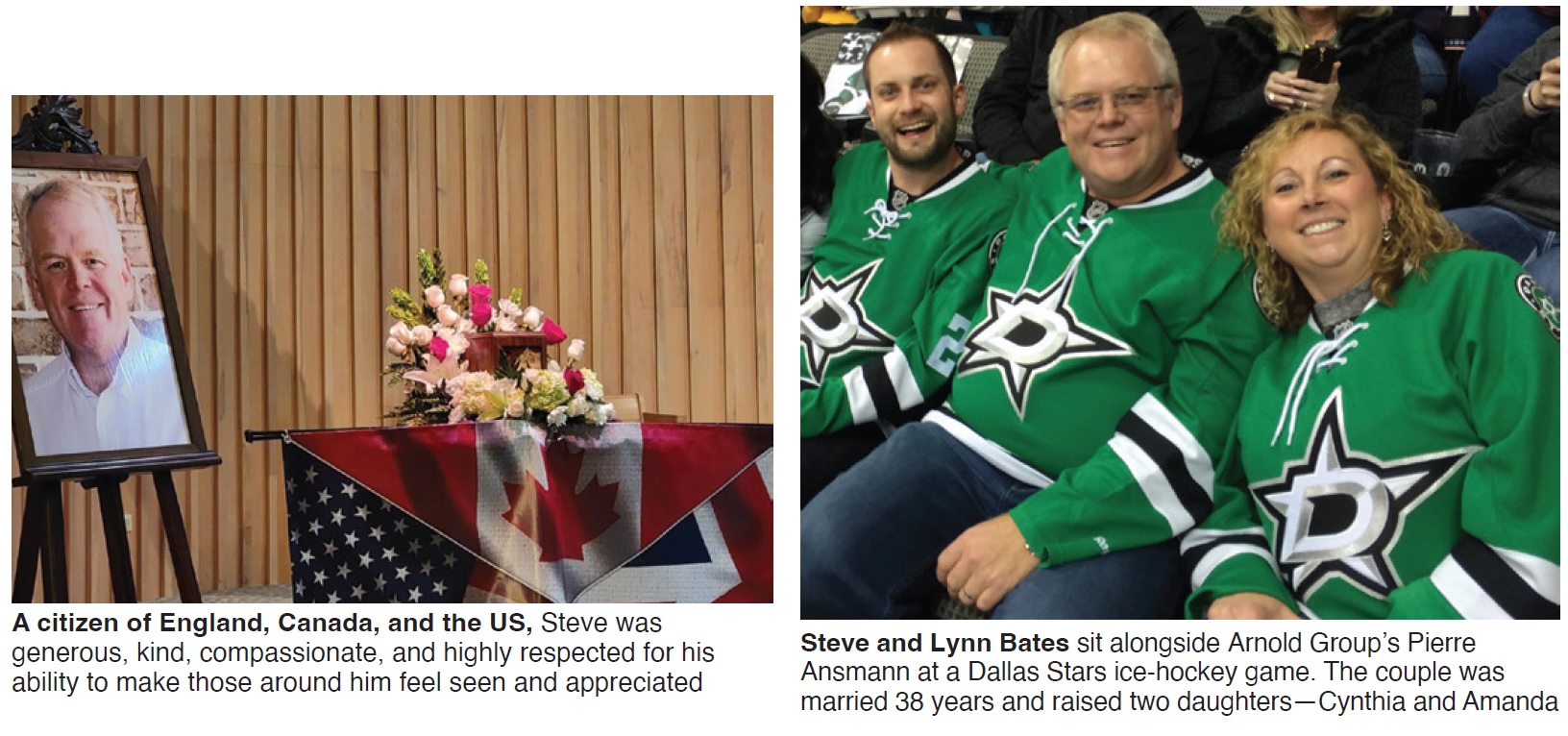
He was a big supporter of CCJ’s mission and an industry luminary who viewed personnel safety as a top priority long before many others. Example: Most recently, and with his company’s support, Steve alerted powerplant owner/operators to the potential for leakage by fuel-gas-heater stop valves and the possibility of an explosive mixture of fuel and air forming in the condenser.
He presented on this possibility at every opportunity—including meetings of the Combined Cycle Users Group, HRSG Forum, and other industry organizations.
In a world that’s prone to short-circuit discussions of findings in accident investigations, Steve was committed to sharing such knowledge to protect powerplant personnel and the public at large; no corners were cut on his watch. Interestingly, he did everything by the book and it didn’t take longer than not.
Some of the people who knew Steve best share their thoughts below.
Steve was such a nice guy. When I heard the coroner revealed that Steve had a large heart, I laughed—as it wasn’t surprising. Everyone knew Steve had a large heart. You knew it from every interaction you had with him. Steve cared! He cared a lot!
Steve cared about me and my family, he cared about my plant and my team, and he cared about my turbine. He cared about all of our turbines! For more than 10 years Steve selflessly led the 501G Users Group, painstakingly tracking and working diligently to manage a multitude of issues to resolution. Steve was a great listener and worked hard to ensure our voices were heard and our issues were brought forward.
It was a joy to watch Steve wrestle with Siemens. His intimate knowledge and understanding of the 501G, his tenacious grasp of current issues, along with his calm demeanor and good humor made him a formidable foe in any debate or discussion. Steve would hang on to an issue like a pit bull, unwilling to let go until Siemens understood and acknowledged his viewpoint. The drama of watching/waiting for his opponent to capitulate was always entertaining. Steve fought for all of us, because he cared, he cared a lot.
After a tumultuous start to 2022 [the Texas deep freeze], Steve turned his focus to Human Performance and the influence it can have both in our success and in the adversity we face. By allowing the 501G users access and insight into a significant event at his plant, and specifically how human interaction influenced several contributing causes, he gave us an understanding of why it is important that we improve our understanding of Human Performance and strive to integrate human-performance tools and processes into our daily lives.
Again, Steve did this because he cared. He cared a lot. His caring and support will be profoundly missed.
Mark Winne
I am privileged to have worked for Steve for over 14 years. He was a great mentor and friend. Steve showed me the ropes and gave me the tools to be a successful manager. He had a wonderful personality and was deeply engaged with every team member at the plant. Steve’s dedication, knowledge, kindness, and loyalty to the team was key in developing a great culture and family atmosphere at Wise County.
I loved being able to walk in Steve’s office, sit down, and brainstorm ideas to improve plant performance, or even to just share thoughts on recent events. Everyone at the plant has a deep void with the loss of Steve and we will never forget all that he brought to each of our lives. He will be forever in our hearts.
Michael Coffman
I met Steve many years ago through the 501G Users Group. As Chairman for more than 10 years, Steve was very approachable and inviting for anyone to participate. He provided strong leadership for our group with his industry knowledge, and his ability to establish great relationships with all 501G frame owners, vendors, and Siemens. Steve was an open book, always willing to share for anyone who wanted to learn more. He was professional and had a great moral compass. I did not work with Steve as closely as those who interfaced with him on a daily basis; however, he has left quite an impression on me. Steve will be greatly missed.
Kevin B Robinson
Whether on a fishing boat or in the corporate boardroom, you knew that friendly smile and outgoing personality were always going to be there to greet you. I met Steven Bates while working as a contractor in Arkansas. He was managing the Tractabel facility just outside of Malvern and had a small job for us to do that turned into a very big job and eventually me going to work for him full time—an invitation I always will be grateful for.
Steven was a study of many things and always on top of recent activities, not only in the power business, but anything that piqued his interest. Steven’s leadership with the 501G Users Group is one of the reasons why the G frame has been so successful. He always brought the skills of team-building and inclusion to the table, and doing so with the Siemens team, made our user group’s effort a great environment as well as very productive. We were able to work together to solve many problems in this frame as it was being developed.
Steven was a tri-citizen of the world. Born in England, he moved to Canada and then to the United States; he had citizenship in all three countries. I was working with Steven as he studied for his US citizenship test, learning a few things myself in that process. He and wife Lynn worked hard, passed the test, and were awarded citizenship. Flags of the three countries draped the table displaying the urn with Steven’s ashes (photo).
But above all, Steven’s relationship with his god, wife, children, and grandchildren were always something to aspire to, and as in many other things, Steven led by example in all of these areas. Our industry will miss Steven Bates; I will miss him for his friendship and camaraderie.
Neal Coffey
Having known Steve for the past dozen or so years and working directly with him on the 501G Users Group steering committee for the last decade, words cannot describe the personal and professional loss that we are all feeling. Steve was always willing to help and share his knowledge and experience with anyone needing it. As the committee chair, he worked tirelessly to promote a culture of respect, openness, and integrity among users, vendors, and OEMs.
Although Steve will be missed by all, his legacy will live on through the memories, accomplishments, and friendships made throughout the years. I will personally miss his friendship and camaraderie, in addition to all of the other outstanding character traits that made him the person he was.
John R Wolff
Steve Bates was an exceptional person who will be dearly missed by the Vistra family and the 501G Users Group. He became chairman of the 501G steering committee in 2011 and has provided years of dedicated service. Steve’s leadership on the committee was what drove the 501G users to become a very close-knit family that was well informed of all the issues we were dealing with on the G frame. When I think of Steve, I see a family man, a leader, a communicator, a friend, and a mentor that I will miss.
Scott Wiley
Many years ago, while attending my first 501F and 501G Users Group conferences, I noticed a few guys sitting off to the side of the podium and, based on their looks and my read on their demeanor, I was quickly wondering what I had gotten myself into. One of them was someone I worked with, Pete Sobieski, but the vibes the other two gave off was scary. Turns out they were Mark Winne and Steve Bates, and oh how wrong my read was.
Fast forward almost two decades and I dare say I was barely tapping into the deep well that was Steve Bates. While the last few years have been filled with uncertainty, loss, and changes to the status quo, I consider myself privileged to have grown closer to Steve and wife Lynn during that time.
I feel very fortunate to have vivid memories of what turned out to be our last in-person evening together at Dezerland. Steve, Lynn, myself, and a few others were enjoying some beverages and desert and Steve was laughing harder than I had ever seen. Turns out he found the idea of me on a little Vespa hilarious. That was a wonderful evening and I will always have that memory of him happy and jovial.
Over the last year, the 501G Users Group, which Steve was chairing, got very involved in working with us on the upcoming conference and in that light Steve had just finished working with a Human Performance organization and you could tell it had really kindled a flame for him. He was so excited he brought it to the Boards of both user groups and we decided to include it in the upcoming conference.
Steve was a man of commitment, honor, and grace. His passion for what we do, and how we do it, was awesome to see after such a distinguished career, when some folks are just riding the wave. Steve was full-steam-ahead and just as passionate before his vacation as he was when I met him all those many years ago.
I will miss his unassuming nature, the roles that he filled so well, and the counsel he offered. More importantly, I will miss the person that he was. The author, A A Milne (Winnie the Pooh) summed up so much in the following sentence: “How lucky am I to have something that makes saying goodbye so hard.” I offer, in closing, that all of us who knew and worked with Steve were indeed lucky.
Ivan Kush
I still don’t know what to say. When I heard the news, the first thing I thought was that we still owed Steve a lube-oil pump that we had borrowed.
When we were at the 501G Users Group meeting in Orlando this past May, I ended up in the hospital. Steve called and wanted to come spend time with me so I wouldn’t be alone. He then reached out to ensure I made it home, and reached out again a few days later to see how I was doing.
Steve was one of the most genuine people I have ever met. He had a very calming way about him and no matter what subject I called to discuss, I always came away with a completely different perspective. Knowing and working with Steve has made me a much better person, and I will forever miss him.
Steve Cole
Steve Bates was my friend and a role model for more than 10 years. Steve’s passing it hit me really hard because only a few hours earlier I was commenting on his Facebook post about spending holiday time in Hawaii.
As plant manager, Steve was at all times very knowledgeable, calm, and relaxed. He always had a smile on his face—even during the toughest negotiations. I visited him at Wise County annually and spent quality time with Steve at the many turbine conferences we both attended. He was highly respected in the industry, inspiring, and a caring person who always put family and friends first.
Pierre Ansmann
Leading a user group is no small task: There are many aspects of that role most don’t see. Being a good leader takes a lot of knowledge, professionalism, interpersonal skills, and tact. Steve Bates was a great leader and helped build a solid framework for cooperation and engagement that helped solve many concerns for the W501G fleet that has benefited both the users and Siemens Energy.
I had the privilege of working with Steve and truly believe we would not have been as successful without his involvement. When we first met, the fleet really needed attention and a different approach to tackle some of the tough challenges present in the fleet. He helped pioneer a new way of working with Siemens Energy, and while holding us accountable, was fair in his approach and used his collaboration skills to bring both sides together for the benefit of the fleet.
His engagement allowed us to amplify our interface with better ways to communicate and resolve some of the toughest issues facing the frame. For a period of time, we executed four face-to-face customer meetings annually—including “deep dive” technical meetings as well as monthly net meetings to help everyone stay on top of the rapid pace of development of solutions.
Steve helped bring the customers together and was instrumental in creating an atmosphere of cooperation and inclusion that was key to solving some of the most difficult tasks. He was firm and truthful, but also openminded and accepting of others’ inputs and ideas. This leadership made him stand out in the crowd and brought us all together. We are all better today because of the way Steve facilitated positive engagement while building solid working partnerships and friendships. God bless Steve Bates.
Mark Carter, SGT6-6000G product manager
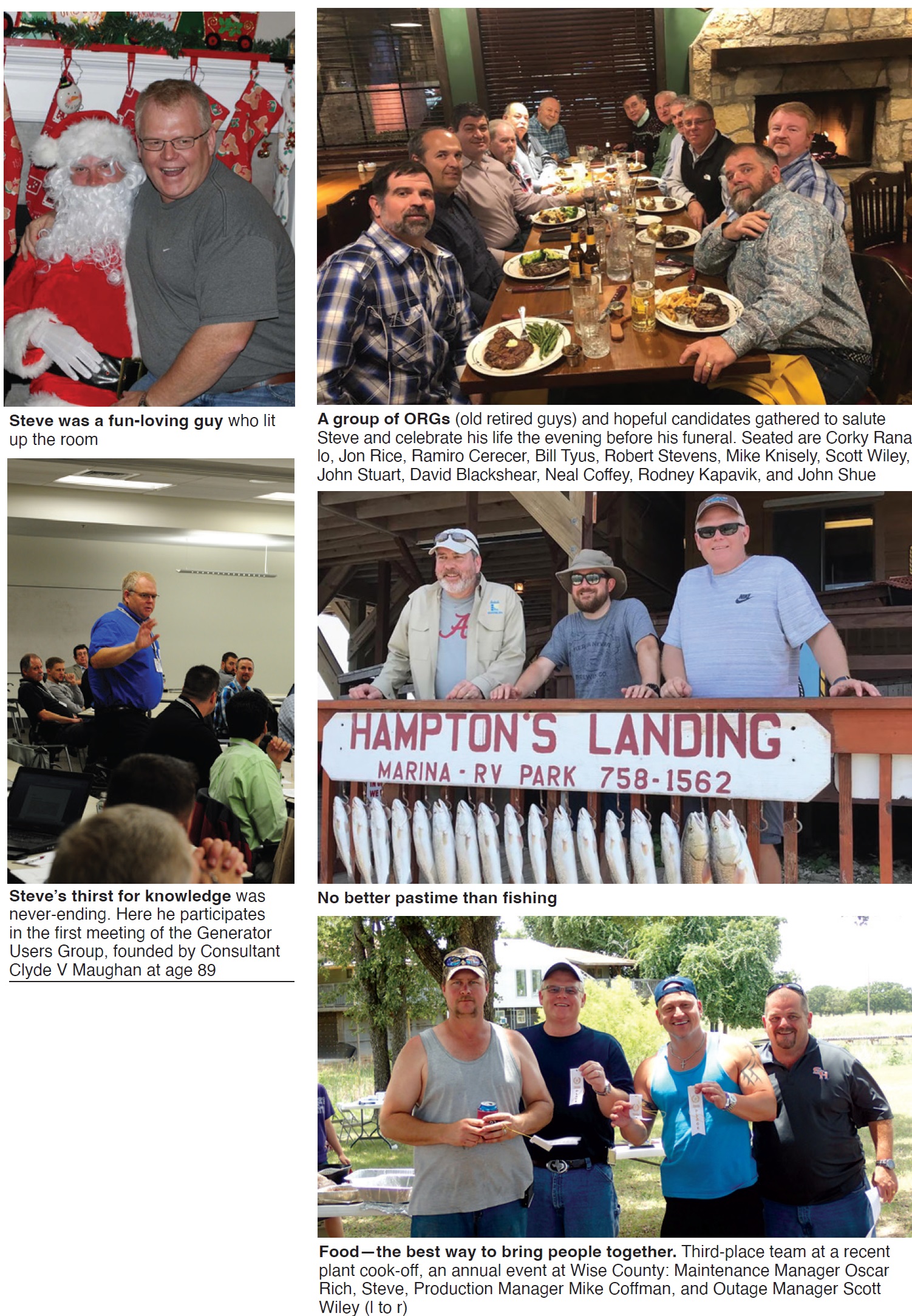
The following presentation recaps focus on Alstom generators from third-party solutions providers at the 2022 AOG virtual conference. Recordings and/or slide decks of all presentations made available to the steering committee can be accessed through the group’s website by registered users. AOG looks forward to welcoming the industry to its sixth annual meeting, March 20-24, at EPRI’s corporate offices and training facility in Charlotte, NC. This will be the organization’s first in-person conference since 2020. A preliminary 2023 conference agenda is posted at www.aogusers.com, where you’ll also find registration, lodging, and other pertinent information. Contact ashley@aogusers.com with any questions.
AGT Services Inc
Alstom WX/WY-21 series air-cooled phase cracking
Jamie Clark, well known to users because of his frequent presentations at user-group meetings presented the case history of an Alstom 60WX-21Z-085 machine that was modified by the OEM in 2016 to prevent phase-jumper connector failures. This generator is relatively common, Clark said, and the information presented is applicable to several other models as well.
The subject air-cooled, 18-kV generator is rated 188 MVA with 0.85 power factor and Class F Micadur® (GVPI stator). Clark began by reviewing the root causes of stator braze connection issues: Poorly designed/executed joint, vibration attributed to 1/rev and 2/rev frequency drivers, a poor endwinding support system (one that either permits excessive vibration or provides too much restraint), and increasing thermal stress.
The challenges facing owner/operators responding to the OEM’s recommendations in its bulletin on phase lug cracking can be formidable. Recall that there are thousands of brazes in a generator—all done manually and then insulated manually.
Visual inspection is virtually impossible in some cases given joint location. Plus, even if the field is removed and the joints are accessible, you can’t see them unless the insulation is removed. Radiography is an alternative, but that has its own challenges, personnel safety among them. UT and use of a thermal-vision camera may be your best option to identify poor braze quality and cracking before a failure occurs. Clark shows how this is accomplished by way of superior illustrations and explanation in the recorded presentation.
It’s important to avoid a failure, especially given the GVPI stator which is very difficult to rewind. Remember, too, a failure typically generates carbon and copper byproducts from the burning that occurs and they are ingested by the fan and distributed throughout the unit. The field is affected, of course. Likely, rings will have to be removed and the rotor rewound.
However, those are not your only concerns. The redesigned joints add mass, changing the resonant frequency of the endwinding support system. Expect that de-tuning also will be required.
Generatortech Inc
Generator rotor winding shorted-turn detection: Flux-probe theory and case studies
David Albright’s conclusions suggest what you can expect to learn from his presentation. They are:
- Shorted turns in field windings occur frequently. While not a big issue in many cases, they can be a serious and expensive problem.
- Online testing is critical because offline tests will miss speed- and temperature-dependent turn shorts.
- Testing over a full range of loads is critical to identify all true turn shorts and eliminate all false turn shorts.
- Installing flux probes during outages can save time and money on future generator maintenance decisions.
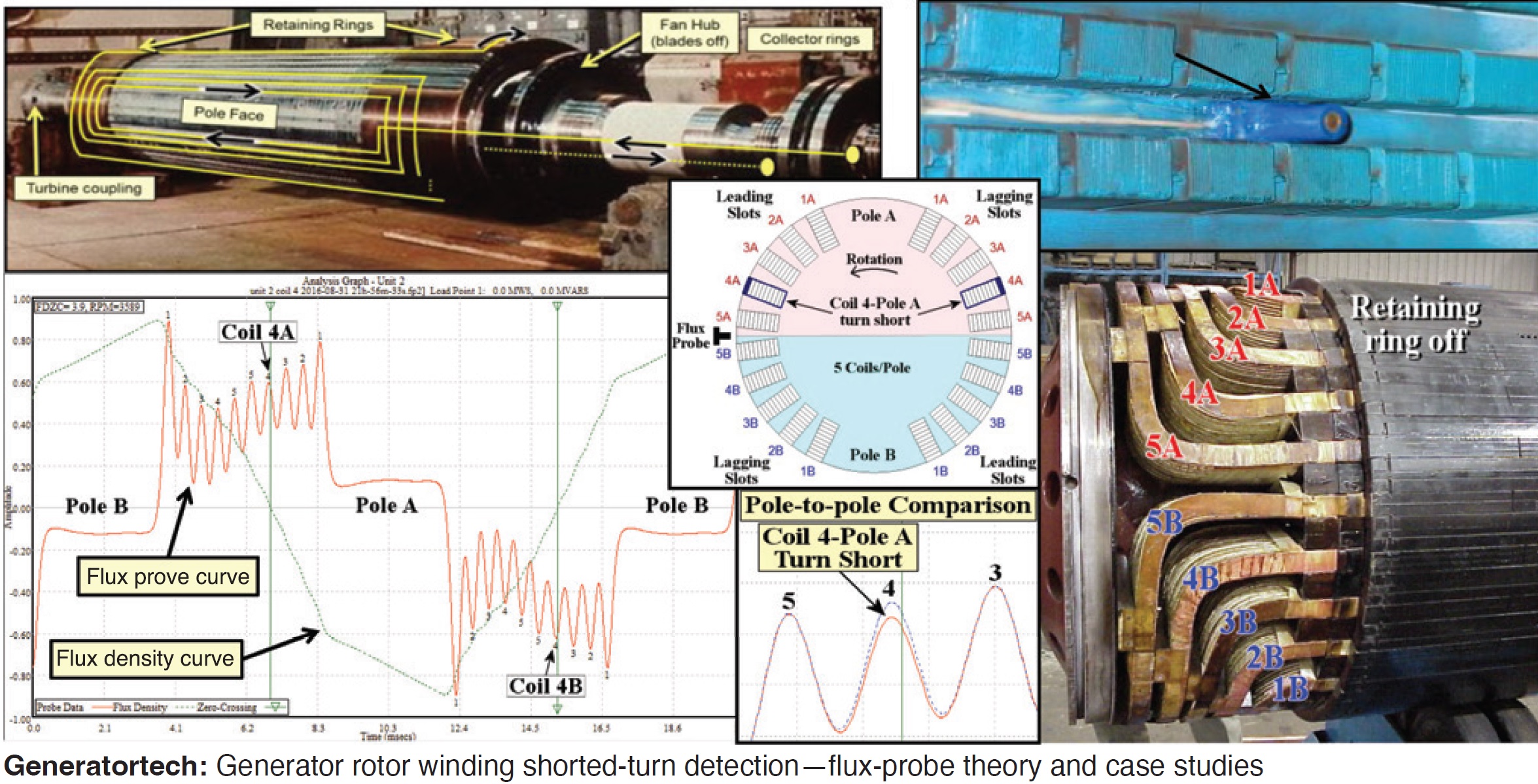
Albright explains turn-to-turn (and coil-to-coil) shorts with good illustrations and provides photos of typical damage. Beware the vicious cycle of turn short development, he warns, explaining that each turn short creates higher temperatures that increase the likelihood of new turn-short development, possibly leading to rapid insulation degradation. Example given: Rapid degradation of a rotor winding for a 680-MW generator caused an increase in turn shorts from two to 10 in 18 months. Several two-pole rotor case studies enhance the learning experience.
The following presentation recaps focus on Alstom steam turbines from third-party solutions providers at the 2022 AOG virtual conference. Recordings and/or slide decks of all presentations made available to the steering committee can be accessed through the group’s website by registered users. AOG looks forward to welcoming the industry to its sixth annual meeting, March 20-24, at EPRI’s corporate offices and training facility in Charlotte, NC. This will be the organization’s first in-person conference since 2020. A preliminary 2023 conference agenda is posted at www.aogusers.com, where you’ll also find registration, lodging, and other pertinent information. Contact ashley@aogusers.com with any questions.
ARNOLD Group
Insulation systems for Alstom gas and steam turbines
Pierre Ansmann opened his presentation on “the most advanced turbine insulation combined with a high-performance heating system to improve startup flexibility,” by summarizing its value proposition thusly:
- Increased in-market availability.
- Lower startup costs.
- Reduced thermal fatigue and longer mean time to repair for critical components.
- Increased operating flexibility.
The ARNOLD system features interlocking high-performance blankets which conform perfectly to the turbine surface. High-quality materials and manufacturing, and long-term high-temperature resistance, allow the company to guarantee reuse of its insulation system for 15 outages without a decrease in efficiency.
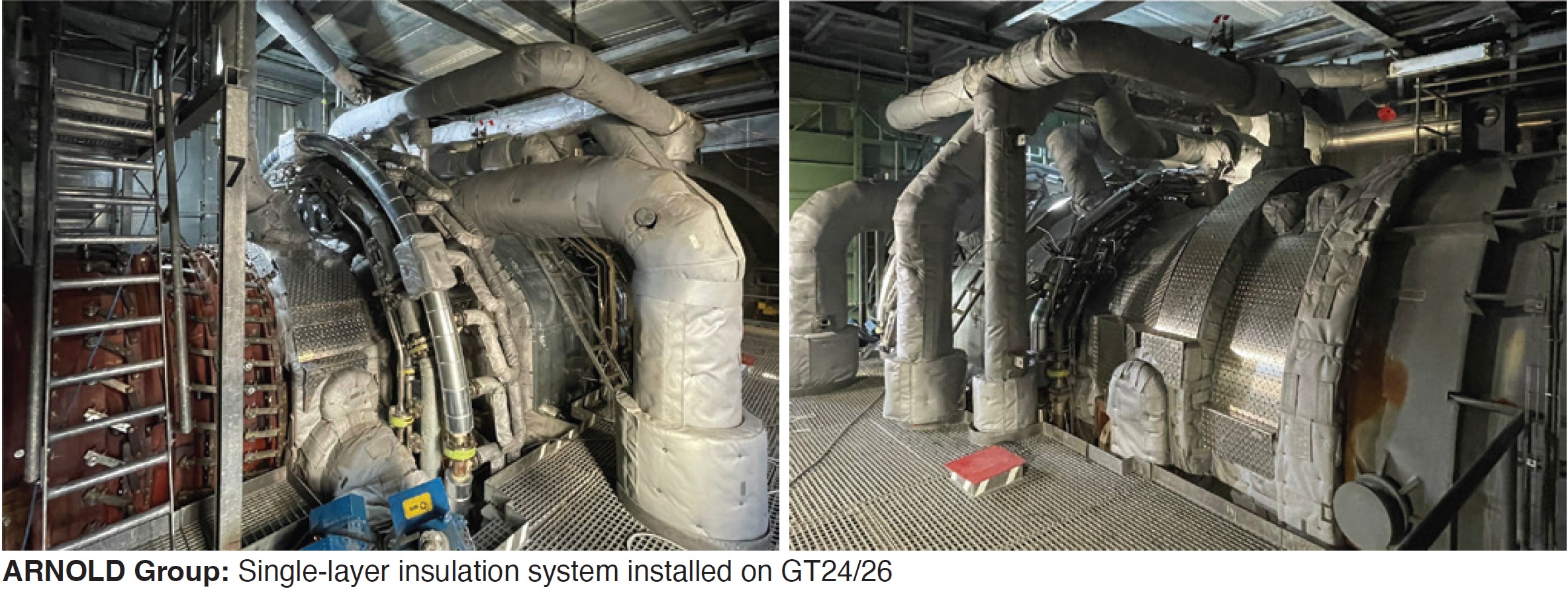
Dozens of thermocouples, strategically located on the turbine, ensure proper heating. Each of the 18 or so heating zones has t/cs installed on the heating wires to double check that the zone is responding correctly and at the specified temperature. Below every heating zone, multiple t/cs are mounted on the casing to confirm even heating of the turbine.
A properly maintained ARNOLD insulation system is said to maintain your turbine in a hot-start condition for at least four or five days after shutdown. No preheating of the unit is required prior to a start within this time period, reducing startup fuel consumption and auxiliary power.
Major portions of the presentation are dedicated to the GT24/26, and GT11N and GT13D. A special focus on ARNOLD’s repair solution for inner insulation at the exhaust diffuser was another highlight of Ansmann’s presentation encompassing more than 60 slides.
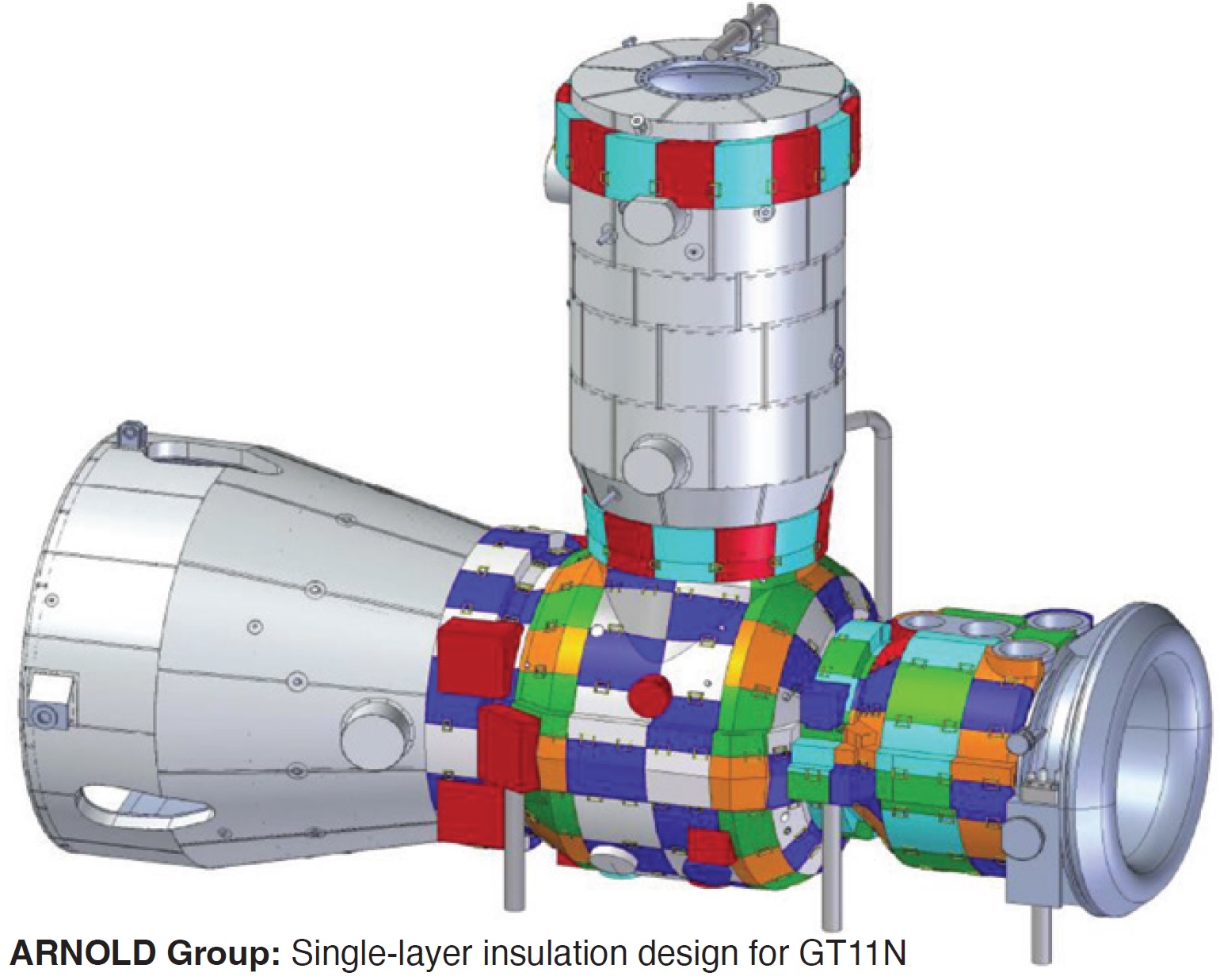
Mechanical Dynamics & Analysis
Alstom steam-turbine casing repairs
Dave Rasmussen, PE, explains MD&A’s engineered casing repair methods that apply to Alstom steam-turbine designs and materials. He covers typical casing-related overhaul inspections and dimensional checks, plus the more common repairs to correct wear, mechanical damage, distortion, and steam leakage. Photography facilitates understanding stationary-blade repair and seal-strip replacement and machining as well as the re-rounding of HP turbine casings.
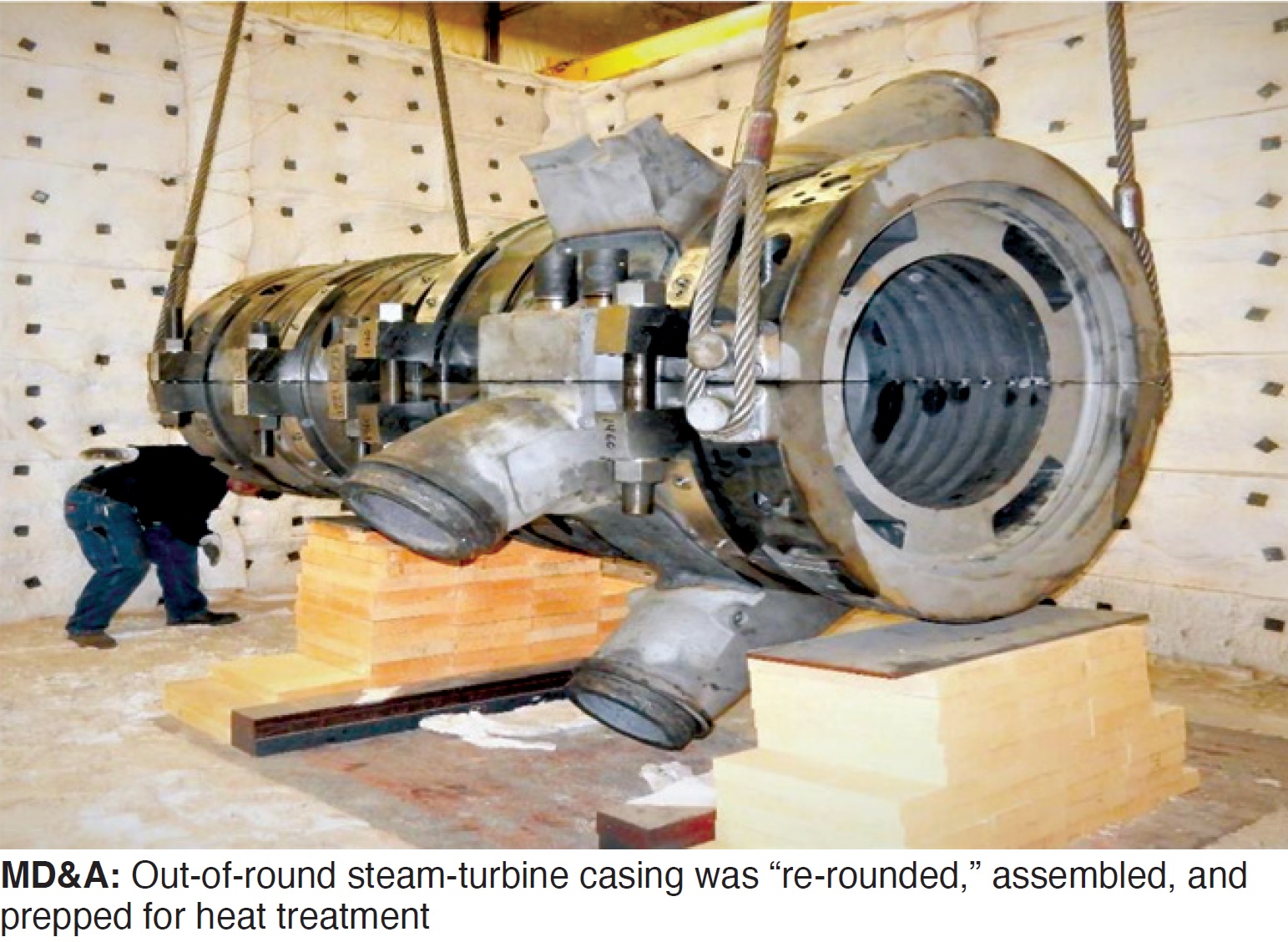
The following presentation recaps focus on Alstom gas turbines from third-party solutions providers at the 2022 AOG virtual conference. Recordings and/or slide decks of all presentations made available to the steering committee can be accessed through the group’s website by registered users. AOG looks forward to welcoming the industry to its sixth annual meeting, March 20-23, at EPRI’s corporate offices and training facility in Charlotte, NC. This will be the organization’s first in-person conference since 2020. A preliminary 2023 conference agenda is posted at www.aogusers.com, where you’ll also find registration, lodging, and other pertinent information. Contact ashley@aogusers.com with any questions.
Doosan Turbomachinery Services
GT 11NM rotor lifetime assessment and fleet management
Come up to speed on Doosan’s capabilities by accessing this presentation. It begins with a short overview on the parent company’s activities in the power industry and beyond. Highlights include drop-in replacements for major steam-turbine sections—such as the HP/IP.
Next is a review of Doosan Turbomachinery Services’ capabilities in Houston—including gas- and steam-turbine component repair, rotor inspection and assessment, welding, heavy mechanical work, parts, onsite services, etc.
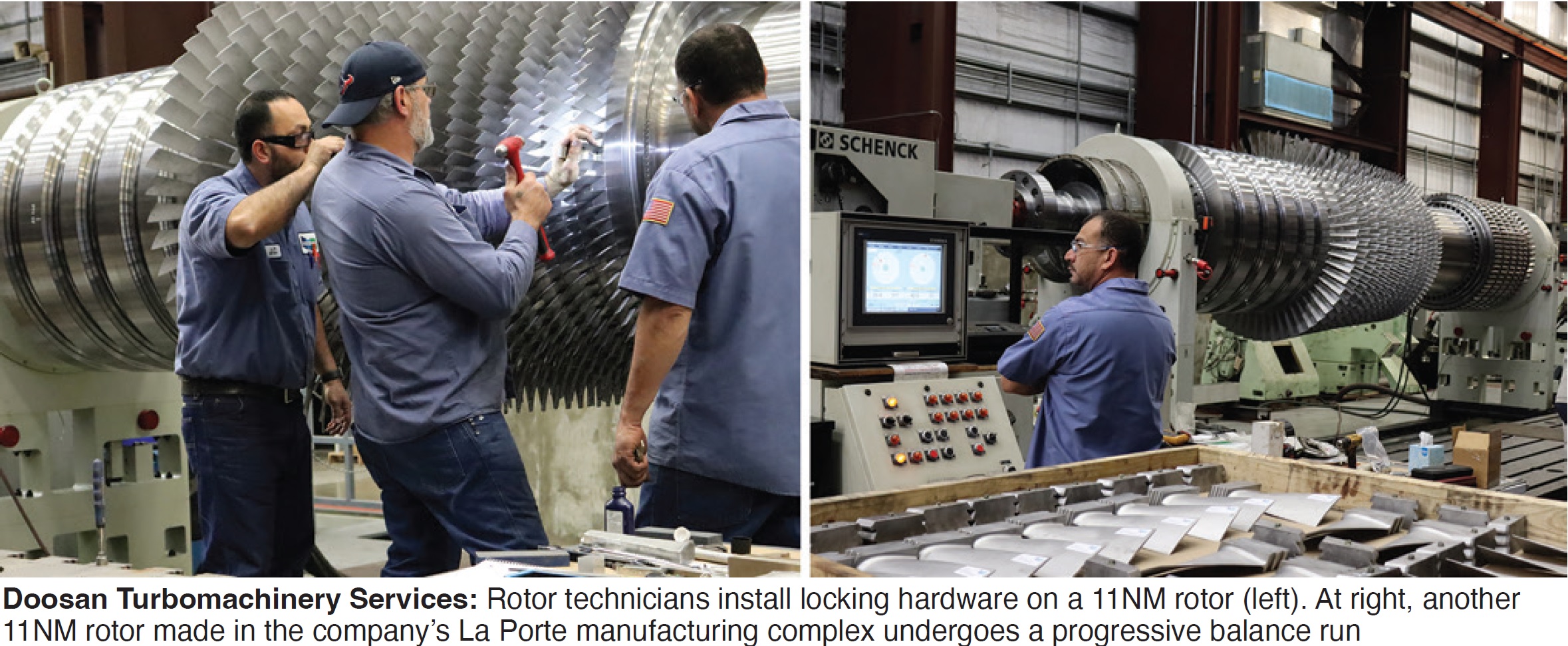
The meat of the presentation is a review of several rotor-repair case studies with a focus on C-inspections and the advance planning they require. Standard inspections and activities performed in Doosan’s Houston rotor shop are reviewed next: visual, bearing journal diameter, seal diametrical inspections, and full NDE evaluation, plus rotor cleaning, rotor runout, rotor balance, and metallurgical evaluation.
Goal of the inspection effort is to find indications in critical areas that, at expected intervals, could adversely impact rotor lifetime. The company’s rotor modeling and thermal-mechanical analysis capabilities provide a critical assist in this regard.
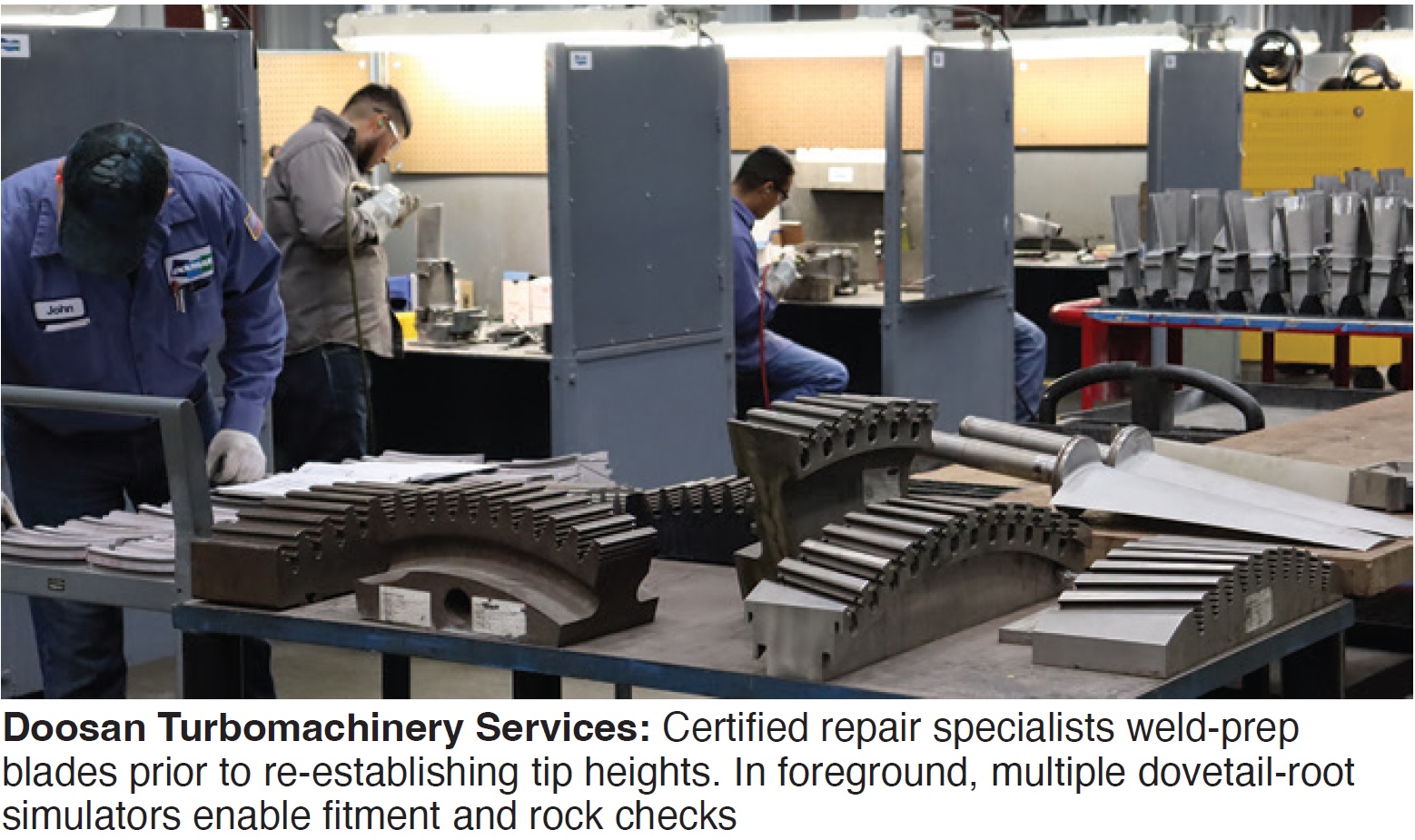
In-depth repair capabilities also are reviewed by the presenter. They include L-bore mods, indication removal, re-contouring, and transition radius adjustment.
The advantage of having access to a spare rotor was included in a brief section on optimizing the use of fleet assets.
Hughes Technical Services
Alstom gas-turbine services and solutions
HTS is a relatively new company, founded in 2014 by former ABB/Alstom engineers, most recently acquired by the AP4 group and its suite of complementary business units serving the CCGT market. If you want to know what Hughes can do for you regarding plant commissioning and maintenance, listen to Fernando Velez’s presentation.
The company specializes in control-system service, upgrade, and retrofit, and excitation and frequency conversion. Plus, gas- and steam-turbine services, along with balance-of-plant solutions. It also offers tools for monitoring pulsations and blowoff valves, which owner/operators mentioned as being of concern to them (see section with user presentations).
Liburdi Turbine Services
User-driven reverse engineering of GT components: Practicality of new technologies and strategies
Doug Nagy, manager of gas-turbine component repair, and four colleagues told attendees that successfully reverse engineered gas-turbine components can provide cost savings and/or alleviate supply-chain issues. But it’s important for owner/operators to understand the key characteristics of a component, its production processes, and the various costs and lead-times involved.
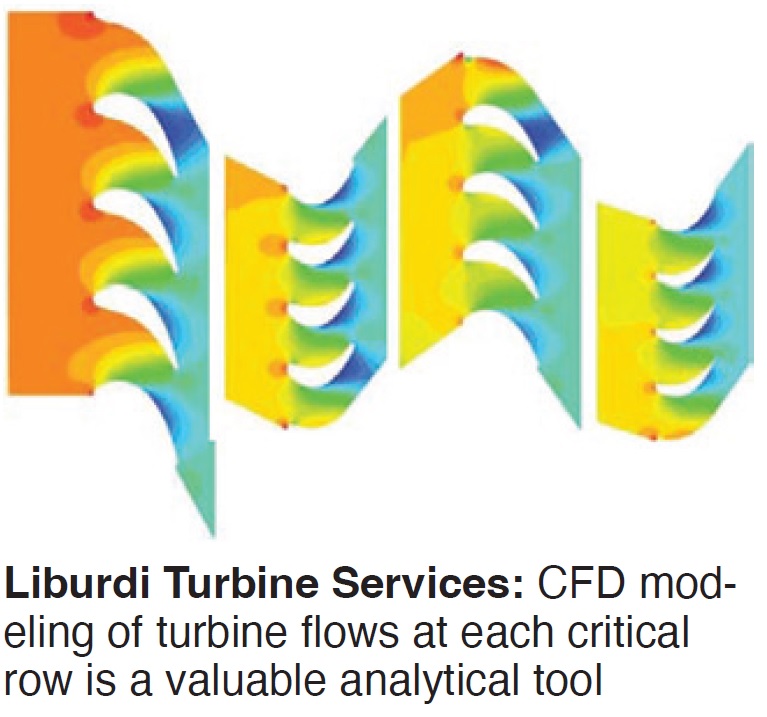
The presentation team assured users that the repair industry already possesses many of the skills required to reverse engineer critical parts. They have been developed over the years to better understand the component designs to address their repair needs and implement upgrades as appropriate. The tools and analyses required for successful reverse engineering are detailed in the slide deck.
ST Power Services
GT lifecycle and plant obsolescence management
Presentation begins with a list of general challenges facing owner/operators of powerplants powered by gas turbines—such as rising O&M costs, evolving pricing models, aging technology and workforce—and spends the remainder of the podium time discussing the company’s portfolio of solutions and services for Alstom GT8, GT11, GT13, and GT24/26.
PSG Power Services Group
Recent field-service projects
Mike Lake, VP sales, began his presentation by introducing key company personnel formerly associated with Alstom and summarized PSG’s considerable experience in the inspection and repair of Alstom gas turbines (GT8 and GT11) and steam turbines.
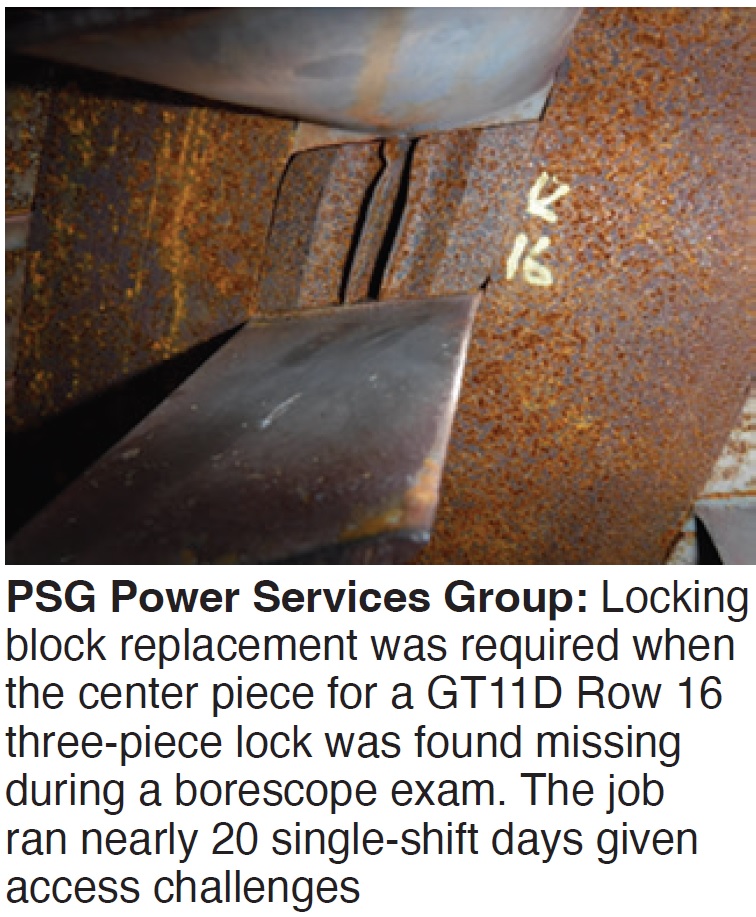 Then he dove into specific recent projects to validate the company’s capabilities. They included the following:
Then he dove into specific recent projects to validate the company’s capabilities. They included the following:
- A-inspections on the bearings and HP/IP/LP stop and control valves for a 479-MW STF60 commissioned in 2018, plus LP crawl-through and HP/IP borescope. Photos and notes provided give details.
- B-inspections on the IP stop valves for a 190-MW STF. Planning for C-inspection in 2023 was included in the work scope.
- A/B-inspections on a GT11N1 included work to secure the unit’s inner gas ring.
- B-inspections and repairs to key components of a GT11N2 (hot-gas casing upper intake, flow separator).
- Locking-block replacement for a GT11D found missing the center portion of its block during a borescope inspection.
Vibro-Consult AG
Vibration analysis and balancing
Fabio Massaccesi, senior vibration expert, described the capabilities of this small enterprise with extensive knowledge and experience in the area of measurement and vibration technology for rotating power generation equipment and industrial machines. Pertinent to user members of the Alstom Owners Group, Vibro-Consult has helped owner/operators with solutions for the GT8, GT9, GT11, GT13, and GT24/26, plus single- and multi-shaft combined cycles with both air- and hydrogen-cooled generators.
Specific services include the following:
- Root-cause analysis and advanced troubleshooting.
- Vibration investigation and analysis.
- Condition monitoring.
- In-situ balancing of rotor trains during operating periods and after major inspections.
- Vibration training.
- Multi-plane rotor balancing.
- Computer-aided balancing.
Höganäs AB
Introduction to TBC and Höganäs’ REO-SZ low “K” TBC
David Sanson’s presentation begins with a crash course on standard thermal barrier coatings (typically 7-8% yttria partially stabilized zirconia, used effectively for more than 50 years) and their morphologies and microstructures. He then reminded attendees that conventional TBCs may be challenged at today’s high firing temperatures, pointing to numerous recent patents for advanced coatings.

Sanson then discusses the benefits of his company’s low-kappa REO-SZ (Amperit® 808.006), a product users might want to investigate. Data presented include thermal conductivity, thermal-shock-test results, and SEM and phase analysis (EDS and XRD). Höganäs offers a wide range of powders that meet Alstom specs.



